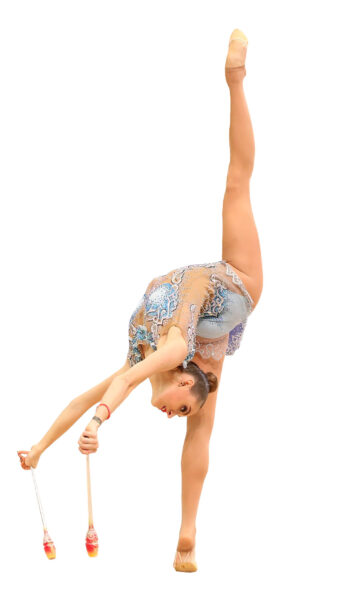What is Rhythmic Gymnastics?
Learn about this beautiful sport
Rhythmic gymnastics is a sport in which individuals or groups of five manipulate one or two pieces of apparatus: rope, hoop, ball, clubs, ribbon and freehand (no apparatus). Rhythmic gymnastics is a sport that combines elements of ballet, gymnastics, dance, and apparatus manipulation.
The victor is the participant who earns the most points, determined by a panel of judges, for leaps, balances, pirouettes (pivots), apparatus handling, and execution.
The choreography must cover the entire floor and contain a balance of jumps, leaps, pivots, balances (a certain number is required depending on the gymnast’s level) and flexibility movements. Each movement involves a high degree of precision. Rhythmic Gymnastics developes strength, power, flexibility, agility, dexterity, endurance and hand-eye coordination.
The size of the competition area, which is a gymnastics carpet, is 13 m x 13 m.
Rope
The rope may be made of hemp or a synthetic material that retains the qualities of lightness and suppleness. Its length is in proportion to the height of the gymnast. One or two knots at either end are to help keep a hold on the rope during the routine. The fundamental requirements of a rope routine include leaps and skipping. Other elements include swings, throws, circles, rotations and figure eights.
Hoop
A hoop may be made of plastic or wood, provided that it retains its shape during the routine. The interior diameter is from 51 to 90 cm, and the hoop must weigh a minimum of 300g. The fundamental requirements of a hoop routine include rotation around the hand or body and rolling, as well as swings, circles, throws, and passes through and over the hoop. Hoop routines involve mastery in both apparatus handling and body difficulty such as leaps, jumps and pivots.
Ball
The ball is made of either rubber or synthetic material (pliable plastic) provided it possesses the same elasticity as rubber. It is from 18 to 20 cm in diameter and must have a minimum weight of 400g. The ball can be of any color. The ball should rest in the gymnast’s hand and not rest against the wrist or be able to be grasped. Fundamental elements of a ball routine include throwing, bouncing or rolling. The gymnast must use both hands and work on the whole floor area whilst showing continuous flowing movement. The ball is to emphasize the gymnasts flowing lines and body difficulty
Clubs
Multi-piece clubs are the most popular clubs. The club is built along an internal rod, providing a base on which a handle made of polyolefin plastic is wrapped, providing an airspace between it and the internal rod. This airspace provides flex, cushioning impact and making the club softer on the hands. Foam ends and knobs further cushion the club. Multi-piece clubs are made in both a thin European style or larger bodied American style and in various lengths, generally ranging from 19 to 21 inches (480 to 530 millimetres). The skills involved are apparatus mastery and body elements. Clubs are thrown from alternate hands with one club passing underneath the other club and then both caught in the opposite hand to the one from which it was thrown. At its simplest, each club rotates once per throw, the handle moving down and away from the throwing hand. However, double and triple spins are frequently performed, allowing the club to be thrown higher for more advanced patterns and to allow tricks such as 360s (channes) to be performed underneath.
Ribbon
It is made of satin or another similar material cloth of any color, it may be multi-colored and have designs on it. The ribbon itself must be at least 35 g (1.2 oz), 4–6 cm (1.6–2.4″) in width and have a minimum length of 6m (20′) for seniors and 5m (16.25′) for juniors. The ribbon must be in one piece. The end that is attached to the stick is doubled for a maximum length of 1m (3′). This is stitched down both sides. At the top, a very thin reinforcement or rows of machine stitching for a maximum length of 5 cm is authorized. This extremity may end in a strap, or have an eyelet (a small hole, edged with buttonhole stitch or a metal circle), to permit attaching the ribbon. The ribbon is fixed to the stick by means of a supple attachment such as thread, nylon cord, or a series of articulated rings. The attachment has a maximum length of 7 cm (2.8″), not counting the strap or metal ring at the end of the stick where it will be fastened. Compulsory elements for the ribbon include flicks, circles, snakes and spirals, and throws. It requires a high degree of co-ordination to form the spirals and circles as any knots which may accidentally form in the ribbon are penalized. During a ribbon routine, large, smooth and flowing movements are looked for. The ribbon may not stop moving or else points are taken off.


Learn more about the rules!
Gymnastics in Canada
The first Olympic Games to feature rhythmic gymnastics was in 1984 in Los Angeles, USA, and Canadian Lori Fung became the sports first Olympic champion, taking home the gold medal. In 2006, Alexandra Orlando won six gold medals at the Commonwealth Games in Melbourne, AUS, becoming Canada’s most-decorated athlete at those Games. In 2012, Canada’s senior group made history by becoming Canada’s first-ever group to compete at the Olympic Games, placing 11th in the qualification rounds (source: Gymnastics Canada.)

